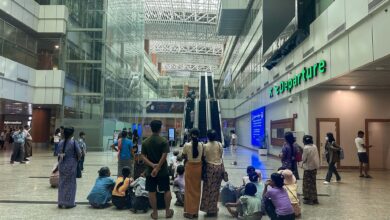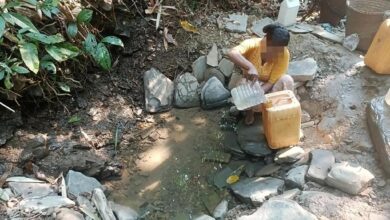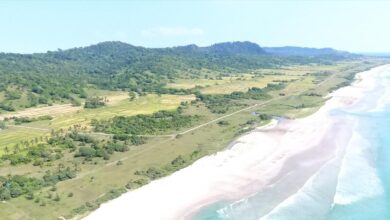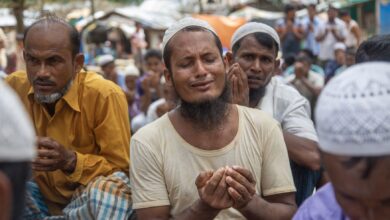
August 11 was a market day in Yin Paung Taing, so the village of nearly 1,000 households, located in Sagaing Region’s Yinmabin Township, was bustling with residents and visitors. The fact that it was also a full-moon day meant that it was even busier than usual.
It was around 3pm that day that Daw Win*, a vendor who sold deep-fried snacks from a stall next to a local teashop, and her 14-year-old daughter first noticed three military aircraft flying over the village. Moments later, the airstrikes began.
This sent everyone scattering in all directions. Then, as chaos reigned, some 60 junta troops arrived by helicopter in the eastern part of the village. Dressed in sports pants and t-shirts, the only thing that identified them as soldiers was their combat helmets and guns, which they fired indiscriminately in all directions.
Daw Win and her daughter were ordered to lie face down on the ground. It was from this vantage point that they witnessed the killing spree as it unfolded.
Almost immediately, they saw one person fall: a 17-year-old boy named Thaw Bhone Naing, shot dead by rampaging regime forces during a massacre that would claim at least 18 more lives before it was all over.
Among the victims were three elderly villagers between the ages of 70 and 83 and a 10-year-old girl named Khin Khine Win. Only four known resistance fighters, including two from Chin State, were confirmed among the dead.
By the time the soldiers left three days later, the village looked like a slaughterhouse. Daw Win said she personally witnessed five killings in all.
“They just shot at everything that moved, including cows, horses and dogs. Nobody and nothing was spared—least of all people,” she said.

Sworn enemies
According to resistance sources based in the area, the likely target of the attack on Yin Paung Taing was a group of 60-80 anti-regime fighters from Chin State who had stopped in the village that afternoon as they were passing through.
Until last year’s coup, southern Sagaing Region had been largely free of the sort of conflict that has long beset Myanmar’s border regions, where ethnic minorities such as the Chin have suffered under decades of military oppression. Now, however, even the majority Bamar in the country’s heartland have turned against the military, making many of them sworn enemies of a murderous regime desperately clinging to power.
All but 5,000 of the nearly 19,000 homes that have been torched by junta forces since the coup have been in Sagaing, according to monitor group Data for Myanmar. Throughout Sagaing and neighbouring Magway Region (which has seen more than 3,000 houses destroyed by fire over the past year), the military has wreaked vengeance on those who have dared to challenge its right to rule.

The coup regime has also used its air supremacy to punish the people of Sagaing. As in Yin Paung Taing, the junta has deployed military aircraft not only to carry out indiscriminate bombing, but also to transport troops into increasingly hostile territory.
Once they are on the ground, these forces cause as much damage as they can. But before they can start destroying property, they must hunt down anyone seen as a potential threat. This means that most men who are unable to escape are either killed on sight or detained, tortured, and later murdered.
The relatively young are at especially high risk. In Yin Paung Taing, 24-year-old Nyein Thu Aung was one of those shot simply for being in the wrong place at the wrong time.
They just shot at everything that moved, including cows, horses and dogs. Nobody and nothing was spared—least of all people
According to Daw Win, he was just metres away from her stall when junta troops opened fire on him.
“We tried to tell the soldiers that he was just buying snacks from my shop, but they wouldn’t listen. Two soldiers shot him at the same time,” she said.
Before he died, Nyein Thu Aung asked Daw Win’s daughter for some water. But she didn’t dare move. She and her mother remained motionless, fearing that they would be next if they did anything to help the dying young man.
“He was in agony,” she said, her voice trailing off as she recalled his final moments. “He died soon after that, just a short distance from my shop.”
Killing in cold blood
After this, the soldiers started herding people at gunpoint into the teashop near Daw Win’s stall. From there, they were moved into the ordination hall at the local Buddhist monastery, where they could all be gathered in one place.
Still in shock at what she had seen, Daw Win’s daughter was trembling so much that she could hardly move. But her mother, terrified at the thought of what would happen if they didn’t obey the soldiers’ orders, made sure they both made their way to the ordination hall, which was full of old people, women, and children. Daw Win was overjoyed to find that her two other children–her 17-year-old daughter and 12-year-old son–were among them.
It was while she was there that Daw Win watched in horror as another young man was killed. The victim, who was in his 20s, pleaded for his life, saying that he wasn’t even from Yin Paung Taing. But far from helping him, this information only triggered an even more brutal response from his captors, who kicked and punched him repeatedly, before finally beating him to death with a mallet used for ringing pagoda bells.
“They hit him twice with the mallet. Blood spewed out of his mouth, and after the second blow, he just stopped moving,” Daw Win recalled.
Another man met a similarly brutal end after it was discovered that he had a tattoo of Myanmar’s ousted state counsellor, Aung San Suu Kyi, on his back. He was paraded in front of the other captives, who were asked if they knew who the person depicted in the tattoo was. When some answered that it was “Amay Suu”, or Mother Suu, the soldiers were furious.
“Once they heard the response, they called the man over and asked him if he loved his mother that much,” said Daw Win. “They kicked him in the back, and then they took him behind the teashop and shot him.”
The fifth murder that Daw Win witnessed was that of a 45-year-old mentally disabled man named Pwa Gyi, who was well-loved by locals. He had been captured during the raid and was bound with ropes and had a bloodied mouth when he was brought out to be identified by the other villagers.
They told the soldiers who he was and begged them to spare his life, but they insisted that he was an informer for the resistance. They took him to a tamarind tree near the teashop and shot him dead, according to Daw Win.
“After they killed him, they took his body to my shop and left there,” she said.

Fleeing barefoot
During the three-day siege, the captured villagers were not allowed to leave the ordination hall.
“They wouldn’t let us go anywhere, even to the latrine. We had to relieve ourselves just outside the hall,” said Daw Win.
Throughout their ordeal, the captives continued to hear the sound of gunshots, signalling that more people were being killed elsewhere in the village.
When the soldiers finally left on August 14, they took around 30 men with them, as human shields and porters.
“They made them carry their weapons and other things. There was a soldier on either side of each villager,” said Daw Win, describing what she could see from the ordination hall as the junta troops left with their hostages.
After the soldiers left, the sound of aircraft returned, raising fears that the military was about to wipe out the village with another aerial assault. Jets engines roared just overhead.
In the end, however, there were no more airstrikes. The villagers emerged, relieved as the sound of the jets faded after a few minutes. But relief soon gave way to fear again as the horror of what they had lived through began to sink in.
Not even bothering to put shoes on their feet, Daw Win and her children fled from the place where they had been penned in like animals, not knowing from one day to the next what horrific fate might await them.
“We just ran barefoot towards the west of the village,” said Daw Win, describing her urgent need to distance herself from the worst experience of her life.
But physically fleeing Yin Paung Taing was much easier than leaving behind their memories of what had happened there.
With her own trauma still fresh in her mind, Daw Win also had to deal with her daughter’s struggle to cope with what she had seen.
“She barely eats now. That boy was shot dead right in front of her and she is still frightened by the incident,” said Daw Win, speaking to Myanmar Now on August 17.

No longer liveable
Soon after the occupation of the village ended, Daw Win’s husband, Soe Win*, managed to track her down. He had been at a friend’s house when the air raid began and was able to escape before the soldiers arrived.
After reuniting with his family, he took them to a safe place and returned to a location near Yin Paung Taing. While there, he spoke to Myanmar Now about his own experience.
They have decided that Yin Paung Taing is a ‘rebel village’, so they want us to know that they can come again anytime they please
At first, he said, he and his friend thought the planes were just passing over Yin Paung Taing. But when the airstrikes began, he immediately hid under a bed and spent the next hour there until the bombing stopped.
But even before the aerial attack was completely over, the sound of heavy gunfire filled the air. He knew then that it was time to run.
“We weren’t able to look outside to see what was happening. But we could hear their steady gunfire, which warned us they were coming,” he said.
He and about a dozen other villagers, including an elderly woman who had been injured by the shelling, fled in the direction of the Yamar River, which flows near Yin Paung Taing. They waded into the river, which was neck-deep in some places, and made their way downstream for about half an hour. But at some point, Soe Win lost his footing and nearly drowned. He lost consciousness, and regained it only after he was rescued.
“I was very lucky I didn’t die,” he said.
But everything he had on him, including his money and his phone, was lost. For the next three days, all he and the others could do was hide and wait for the soldiers to leave.

On August 14, when they received word that the occupation of Yin Paung Taing had ended, a few of them, including Soe Win, formed a small group to check on the situation. When they returned, they were shocked by what they saw.
“It was devastating. Some houses were torn apart by the shelling, and some had been burned down. And there were dead animals and dead people all over the place,” he said.
The smell of rotting flesh was overwhelming, and the village no longer seemed liveable. But Soe Win and some others, including residents of nearby villages, began the difficult work of trying to clean up and rebuild Yin Paung Taing, despite fears that the military could return at any time and lay waste to it all over again.
If I had a brother who was a soldier, I would kill him and gouge his eyes out
Some, including Daw Win, have decided that they are in no hurry to return to their homes in a village that will never be the same.
“They have decided that Yin Paung Taing is a ‘rebel village’, so they want us to know that they can come again anytime they please,” she said.
Still struggling to make sense of it all, she knows only that her hatred of the military is now absolute.
“If I had a brother who was a soldier, I would kill him and gouge his eyes out,” she said.
“We cannot and must not lose to them.”
*Sources’ names have been changed for their protection.
Reporting by Swe Win and Tin Htet Paing.



